Physical Address
304 North Cardinal St.
Dorchester Center, MA 02124
Many of the primary immunodeficiencies ( Table 5.1 ) are associated with gastrointestinal (GI) lesions. Manifestations of immune deficiency in the GI tract may be broadly divided into three categories : increased susceptibility to infection, idiopathic chronic inflammatory conditions, and increased risk of neoplasia. Although many GI lesions are infectious ( Table 5.2 ), chronic inflammatory conditions resembling celiac disease and inflammatory bowel disease (IBD) ( Table 5.3 ) are seen in many patients with antibody deficiencies and diseases of immune dysregulation and are probably the result of the inability of dysfunctional mononuclear cells to suppress unwanted immune responses. All patients with primary immunodeficiencies are at increased risk of neoplasia ( Table 5.4 ), most commonly non-Hodgkin lymphoma (NHL), and the GI tract is often the primary site of involvement. In addition to the risk of lymphoma, some of the primary immune deficiencies are associated with increased risk of gastric adenocarcinoma and colorectal carcinoma. ,
| Disease | Proposed Cause |
|---|---|
| Predominantly Antibody Deficiencies | |
| Selective IgA deficiency | Impaired IgA synthesis; molecular defect unknown in most cases; mutation in TNFRSF13B in ∼5% |
| Common variable immunodeficiency | Impaired B-cell maturation; molecular defect unknown in most cases; mutation in TNFRSF13B in ∼10%-15%; others include TNFRSF13C, CD19, CD81, CD21, and CD20 |
| X-linked agammaglobulinemia | Mutation in BTK results in absence of BTK in B cells |
| Hyper-IgM syndrome | Mutation in CD40L, leading to absence of CD40 ligand on T cells (CID generally less profound than SCID). Other affected genes reported include AICDA, UNG, INO80, and MSH6 |
| Combined Immunodeficiencies (CIDs) | |
| Severe combined immunodeficiency (SCID) | Multiple defects, most commonly in the common γ chain; Others include adenosine deaminase deficiency, IL7Rα deficiency, JAK3 deficiency, and T-cell receptor deficiencies |
| Omenn’s syndrome | Hypomorphic missense mutation in RAG1 and RAG2 |
| Inducible costimulator deficiency (ICOS) | Mutations in ICOS |
| CIDs with Syndromic Features | |
| Wiskott-Aldrich syndrome | Mutation in WASP gene involved in cell trafficking and motility |
| DiGeorge syndrome | Thymic hypoplasia; microdeletion in 22q11.2 |
| Hyper-IgE syndrome | Mutation in STAT3 (loss of function) in autosomal dominant form; mutation in DOCK8 in autosomal recessive form (CID generally less profound than SCID) |
| Anhidrotic ectodermodysplasia with immunodeficiency | Mutations in IKBKG in X-linked dominant form (NEMO deficiency); Mutations in IKBA (gain of function) in autosomal dominant form |
| Disease of Immune Dysregulation | |
| X-linked inhibitor of apoptosis protein (XIAP) deficiency | Mutations in the BRIC4 gene (encoding XIAP) |
| LPS-responsive beige-like anchor (LRBA) protein deficiency | Bi-allelic mutations in LRBA |
| Immune dysregulation, polyendocrinopathy, enteropathy, X-linked syndrome | Mutations in FOXP3 |
| Cytotoxic T-lymphocyte antigen 4 (CTLA4) deficiency | Heterozygous mutations in CTLA4 |
| Congenital Defects of Phagocytes | |
| Chronic granulomatous disease | Mutations in gene for component of NADPH oxidase; CYBB mutation in X-linked form; mutations in CYBA, NCF1, NCF2, or NCF4 in autosomal recessive forms |
| Defects in Intrinsic and Innate Immunity | |
| Chronic mucocutaneous candidiasis | STAT1 gain-of-function mutation |
| Disease | Gastrointestinal Infections |
|---|---|
| Selective IgA deficiency | Giardia intestinalis ; strongyloidiasis |
| Common variable immunodeficiency | Giardia intestinalis ; Cryptosporidium ; CMV; Salmonella species and Campylobacter jejuni |
| X-linked agammaglobulinemia | Giardia intestinalis ; Cryptosporidium Salmonella , Campylobacter, mycoplasma, Rotavirus, coxsackievirus, poliovirus |
| Hyper-IgM syndrome | Giardia intestinalis , Cryptosporidium , Entamoeba histolytica , Salmonella , Histoplasma capsulatum |
| Severe combined immunodeficiency | Candida ; Salmonella and other bacterial pathogens; CMV, rotavirus, Epstein-Barr virus |
| Inducible co-stimulator deficiency | Campylobacter; Salmonella; Cryptosporidium; CMV; HHV6; norovirus; adenovirus |
| DiGeorge syndrome | Candida |
| Hyper-IgE syndrome | Candidiasis; infections with Cryptococcus ; histoplasmosis |
| Anhidrotic ectodermal dysplasia with immunodeficiency | Mycobacterial infection |
| Chronic mucocutaneous candidiasis | Candida ; Histoplasma capsulatum |
| Disease | Manifestation |
|---|---|
| IgA deficiency | Celiac disease Food allergies Crohn’s disease–like lesion Nodular lymphoid hyperplasia |
| Common variable immunodeficiency | Multifocal atrophic gastritis ± intestinal metaplasia Villous atrophy Nodular lymphoid hyperplasia Crohn’s disease–like lesion Granulomatous enteropathy Colitis (ulcerative colitis–like; lymphocytic colitis) |
| X-linked agammaglobulinemia | Crohn’s disease–like lesion Perianal fistula and perianal abscess |
| Hyper-IgM syndrome | Nodular lymphoid hyperplasia Oral and perianal ulcers |
| Severe combined immunodeficiency | GVHD-like lesion, small bowel and colon Esophageal reflux |
| Omenn’s syndrome | GVHD-like lesion, small bowel and colon |
| Inducible co-stimulator deficiency | IBD-like lesion |
| Wiskott-Aldrich syndrome | Crohn’s disease–like lesion involving colon |
| Hyper IgE syndrome | Eosinophilic esophagitis; eosinophilic infiltration of other GI segments |
| Anhidrotic ectodermal dysplasia with immunodeficiency | Gastric ulcer/erosion; active colitis |
| X-linked inhibitor of apoptosis deficiency | Crohn’s disease |
| LPS-responsive beige-like anchor protein deficiency | Atrophic gastritis; IBD-like disease; collagenous colitis |
| Cytotoxic T-lymphocyte antigen 4 insufficiency | Atrophic gastritis; celiac disease; Crohn’s disease |
| Immune dysregulation, polyendocrinopathy, enteropathy, X-linked syndrome | GVHD-like changes; celiac disease; enteropathy with a complete depletion of goblet cells |
| Chronic granulomatous disease | Esophageal and gastric outlet obstruction; Crohn’s disease–like lesion in small bowel; colitis (ulcerative colitis–like and Crohn’s disease–like) Pigmented macrophages |
| Chronic mucocutaneous candidiasis | Atrophic gastritis |
| Disease | Gastrointestinal Malignancy |
|---|---|
| Immunoglobulin A deficiency | Lymphoma Gastric adenocarcinoma |
| Common variable immunodeficiency | Gastric adenocarcinoma B-cell lymphoma, involving small bowel Adenocarcinoma of the colon, ± neuroendocrine features |
| X-linked agammaglobulinemia | Non-Hodgkin lymphoma Gastric adenocarcinoma Colorectal adenocarcinoma |
| Hyperimmunoglobulin M syndrome | Plasma cell proliferation Colorectal carcinoma High-grade neuroendocrine carcinomas of the gastrointestinal tract and biliary tree |
| Wiskott-Aldrich syndrome | Gastrointestinal lymphoma |
| Hyper-IgE syndrome | Lymphoma |
| LPS-responsive beige-like anchor protein deficiency syndrome | Lymphoma; gastric adenocarcinoma |
| Cytotoxic T-lymphocyte antigen 4 deficiency | Gastric adenocarcinoma |
Defined as a serum immunoglobulin A (IgA) concentration of less than 50 μg/mL, selective IgA deficiency is the most common primary immunodeficiency ; it occurs in 1 of 600 people of Northern European ancestry. , The disorder is 20 times more common in white Americans than in African Americans. Defects in antibody production in patients with IgA deficiency represent a continuum with those seen in common variable immunodeficiency (CVID), and 20% to 30% of IgA-deficient patients also have deficits in IgG subclasses. Mutations in the TNFRSF13B gene have been identified and associated with IgA deficiency. This gene encodes a member of the tumor necrosis factor-receptor (TNFR) superfamily, the transmembrane activator and calcium-modulator and cyclophilin-ligand interactor (TACI), which mediates isotype switching in B lymphocytes (see later discussion). Although the mutational defect remains unknown in many cases, some human leukocyte antigen (HLA) haplotypes have been associated with IgA deficiency. In addition, the pathogenesis of selective IgA deficiency is likely heterogeneous, involving several pathways controlling B-cell functions or regulatory regions of the IGHA (Ig heavy constant α) gene.
Clinical manifestations of IgA deficiency range from no symptoms to recurrent infections (typically involving mucosal surfaces), autoimmune disorders, allergic diseases, and malignancy, but they are typically milder than those seen with CVID. Recurrent upper and lower respiratory tract infections are common in both disorders. Similarly, GI manifestations of IgA deficiency are the same as those associated with CVID. Infections are less common than might be expected, possibly because of compensation for lack of mucosal IgA by transport of IgM across the mucosa into the gut lumen, but include acute diarrheal illnesses caused by bacterial enterocolitis and chronic diarrhea caused by persistent Giardia intestinalis (lamblia) infection. Chronic strongyloidiasis has also been reported.
Susceptibility to autoimmune disorders such as insulin-dependent diabetes mellitus and celiac disease may be inherited together with IgA deficiency; all three conditions are linked to particular major histocompatibility haplotypes and probably represent genetically linked susceptibilities in certain populations. The prevalence of celiac disease, the most common noninfectious GI complication of IgA deficiency, is 7.7% in children with IgA deficiency, compared with 1:500 in the general population. Antigliadin IgA and endomysial IgA antibodies cannot be used as screening tools in the IgA-deficient population, but the morphology of celiac disease occurring in the setting of IgA deficiency is similar to that seen in immunocompetent patients. In addition, a spruelike illness characterized by chronic diarrhea with villous atrophy that does not respond to a gluten-free diet may be seen in IgA deficiency, as in CVID. Pernicious anemia complicating chronic atrophic autoimmune gastritis is seen more commonly in IgA deficiency than in CVID, and nodular lymphoid hyperplasia (NLH) in the small bowel is only rarely reported. As with other B-cell disorders, the incidence of Crohn’s disease and gastric adenocarcinoma appears to be increased in IgA deficiency.
The typical patient with X-linked agammaglobulinemia (XLAG) is susceptible to bacterial infections because of the absence of all circulating immunoglobulin subtypes; mature circulating B cells are low to absent. This disorder is characterized by an inability to make antibodies to virtually all antigens. The molecular basis of most cases of XLAG was elucidated in 1993, when a defect in the BTK (Bruton tyrosine kinase) gene was found , ; subsequent studies have identified numerous deleterious mutations. The BTK gene encodes a nonreceptor tyrosine kinase expressed in B-cell and myelomonocytic cell lineages but not in T cells. BTK functions in intracellular signaling pathways essential for pre–B-cell maturation, but the exact mechanism by which the defects in BTK lead to B-cell maturation arrest remains unclear. XLAG may have more phenotypic diversity than has previously been recognized, because adults with mild or no clinical symptoms but with deficiencies in BTK have been described. Age at onset, disease severity, and phenotype are roughly associated with mutation severity (as classified based on structural and functional consequences) in some but not all cohorts. ,
IBD and Crohn’s disease are less common in XLAG than in CVID, perhaps because of preserved T-cell function in XLAG, although persistent or recurrent diarrhea is reported in up to 65% of patients. , Age at onset of GI symptoms is younger than in CVID patients, and autoimmune diseases are less common. Small-intestinal and colonic mucosal biopsies in the XLAG patient without GI symptoms are notable only for the lack of plasma cells in the lamina propria, giving the lamina propria an empty appearance. Mucosal architecture is unremarkable, and villous blunting is not seen. Approximately one-third of patients are seen initially with GI complaints, most commonly diarrhea or perirectal abscess, and 10% in one study had chronic GI symptoms, either from persistent infection with G. intestinalis, Campylobacter jejuni, Salmonella, mycoplasma, or enteropathic Escherichia coli or secondary to bacterial overgrowth. No cause for chronic diarrhea was found in half of these patients. Chronic infection with rotavirus is also reported in this population. Because biopsies are not routinely performed for this disorder, few descriptions of histopathological findings are available, but moderate blunting of duodenal villi with crypt hyperplasia and an increase in lamina propria inflammatory cells have been reported in acute infections. Degenerative changes may be noted in epithelial cells on the surface of the villus with no increase in crypt apoptosis ; crypt cells are spared, and the crypt zone undergoes a compensatory hyperplasia. The histological changes of acute rotavirus infection are reported to resemble celiac disease but are patchier and quickly revert to normal with resolution of infection.
In addition to GI infections, a chronic ulcerating inflammatory condition, clinically similar to Crohn’s disease, has been reported that is manifested by recurrent diarrhea, malabsorption, ulcers, and small bowel strictures ( Fig. 5.1 ). IBD and enteritis are relatively more common in XLA patients carrying missense mutations with only partial loss of gene function. A prominent lymphocytic inflammatory infiltrate without plasma cells or granulomas is seen in the affected areas. , In one case, enterovirus was found by polymerase chain reaction in inflamed ileum and adjacent mesenteric lymph nodes, suggesting that infection may be responsible for these lesions in some XLAG patients.
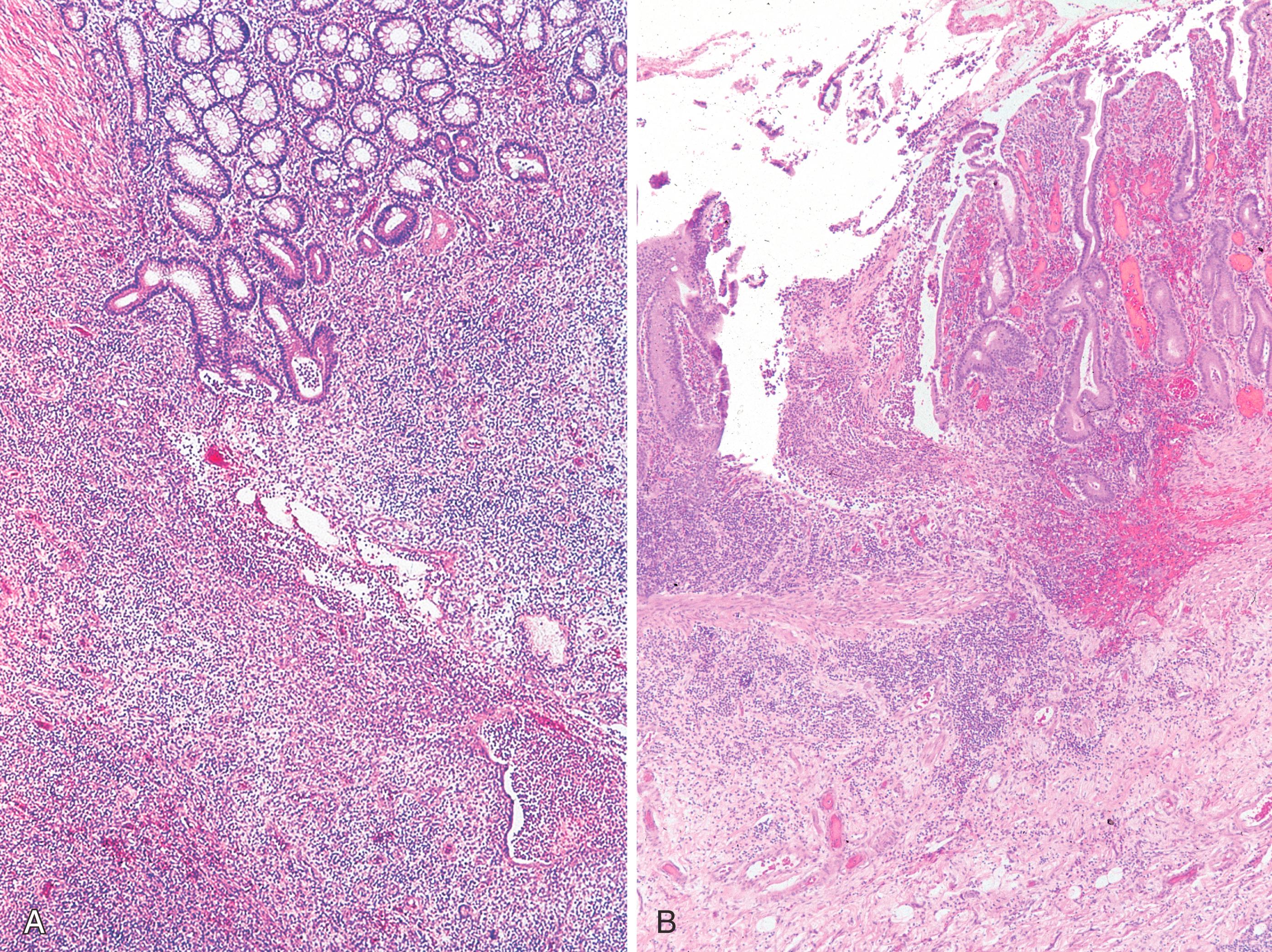
Patients with XLAG are at increased risk for malignancy, even in childhood. The most common malignancy in this group is NHL, which often involves the GI tract, and many of these cases occur in children younger than 10 years of age. There are rare reported cases of gastric adenocarcinoma and colorectal adenocarcinoma. The increased incidence of colorectal carcinoma for patients with XLAG was calculated as 30-fold in one study, although other registry studies have reported few or no colorectal cancers in their patients with XLAG. , In most of the reported cases, XLAG patients with colorectal carcinoma are young adults in their twenties who are seen with advanced-stage tumors. In one reported case, multiple colorectal adenomas in addition to carcinoma were found.
X-linked hyperimmunoglobulin M syndrome (HIMG), the most common form, results from a mutation in the gene for CD40 ligand, which leads to loss of isotype switching. T cells from patients with this disorder lack the CD40 ligand and therefore do not interact with CD40 on the B-cell surface, an event necessary for immunoglobulin class switching. Recessive mutations in CD40 are seen in rare patients with HIMG. X-linked HIMG and HIMG caused by defects in CD40 are generally thought to be a primary B-cell deficiency, but in the 2017 International Union of Immunological Societies (IUIS) Classification, they have been assigned to the category of “combined immunodeficiencies generally less profound than severe combined immunodeficiency.” Rare cases of recessive autosomal HIMG have been reported and are ascribed to mutations in other genes, such as AIDCDA, CD40, UNG, and MSH6, leading to defects in immunoglobulin class-switch recombination and/or somatic hypermutation. , Patients with HIMG have very low levels of IgG and IgA and normal or elevated levels of IgM. They are susceptible to pyogenic infections similar to those encountered in XLAG, and in addition are susceptible to Pneumocystis carinii pneumonia. A variety of intracellular pathogens such as mycobacterial species, fungi, and viruses (e.g., cytomegalovirus [CMV], adenovirus) are implicated in causing disease in these patients. The most common site of infection is the upper or lower respiratory tract (approximately 50% and 80% of cases, respectively). Disseminated infection , and esophageal infection with Histoplasma capsulatum are also reported in X-linked HIMG.
Diarrhea occurs in one-third to one-half of patients , and follows a chronic course in most. Chronic watery diarrhea may be caused by Cryptosporidium infection; G. intestinalis, Salmonella, and Entamoeba histolytica have also been implicated, although in most patients no pathogen is identified. NLH involving the GI tract is reported in approximately 5% of patients. Lymphoid hyperplasia may also result in hepatosplenomegaly, lymphadenopathy, and enlargement of the tonsils. IBD was reported in a few patients with X-linked HIMG and chronic diarrhea. A phenotype of Crohn’s disease and hemophagocytic lymphohistiocytosis was described in a 5-year-old boy with X-linked HIMG. Sclerosing cholangitis is a common and serious complication (affecting about 20% of European patients) and is often related to chronic infection with Cryptosporidium; liver transplantation may be necessary. In one European series, three of five patients infected with hepatitis B developed hepatocellular carcinoma.
Patients with XHIM are prone to autoimmune hematological diseases, including cyclic or chronic neutropenia, and oral and perianal ulcers are common during neutropenic episodes. Massive proliferation of IgM-producing plasma cells may involve the GI tract, liver, and gallbladder, usually in the second decade of life, and may prove fatal. High-grade neuroendocrine carcinoma of the small intestine, colon, and pancreas has been reported in this disorder, and there is an increased incidence of liver and biliary tract tumors.
Although CVID is not a common disorder, it is probably the most common symptomatic primary immunodeficiency, accounting for 12% to 36% of all primary immunodeficiency. Clinical and immunological features are heterogeneous, but most patients are seen with recurrent bacterial infections, usually involving the upper and lower respiratory tracts and leading to chronic lung disease and bronchiectasis. Patients may be seen with CVID at any age from infancy to late adult life with a mean age at diagnosis being around 30 years, and males and females are equally affected. Autoimmune manifestations such as thyroid dysfunction, pernicious anemia, autoimmune hemolytic anemia, autoimmune thrombocytopenia, and rheumatoid arthritis are common, and granulomatous involvement of skin and visceral organs mimicking sarcoidosis may be seen in CVID. Chronic GI disorders resulting in malabsorption and weight loss occur in approximately 20% of patients with CVID.
CVID is characterized immunologically by hypogammaglobulinemia involving multiple antibody classes. T-cell abnormalities are common; below-normal proliferative responses to mitogens are found in 40% of patients, and 20% have a relative lack of CD4+ T cells. The common abnormality shared by IgA deficiency and CVID is failure of terminal maturation of B lymphocytes into plasma cells producing various Ig subtypes. A primary B-cell defect is favored in many patients, but in others defective antigen responsiveness in helper T cells may be the underlying basis for the disorder.
A genetic basis has long been suspected, based on the observation that familial inheritance of CVID occurs in 20% of cases and that CVID and IgA deficiency tend to occur in the same family; individual family members may gradually convert from one disorder to the other. In multiple-case families, CVID is often present in the parents and IgA deficiency in the offspring, consistent with the hypothesis that CVID may develop later in life as a more severe manifestation of a common defect involving immunoglobulin class switching. In the majority of CVID patients, however, the underlying genetic basis is unknown. CVID is thought to be a polygenic disease for most patients, with monogenetic defects only identified in a small portion of cases. Studies of isotype switching led to the discovery that the TNFRSF13B gene, which encodes the member of the TNFR family, TACI, is mutated in approximately 10% to 15% of patients with CVID and 5% of patients with IgA deficiency. TACI mediates isotype switching in B cells and survival of plasma cells. TACI is also involved in central B-cell tolerance and inhibiting peripheral B-cell expansion, and this may be the basis for the susceptibility of patients with TACI mutations to autoimmune and lymphoproliferative disorders. New gene defects in BAFFR (TNFRSF13C), CD19, CD81, CD21, and CD20 (now called MS4A1 ) resulting in a CVID phenotype have been described in a small number of patients, , underscoring the genetic heterogeneity of this disorder, and next-generation sequencing studies have identified numerous candidate causative genes. In addition, genome-wide association studies have demonstrated a strong association of CVID with the major histocompatibility region.
Patients with CVID are at particular risk for chronic inflammatory disorders and malignancies affecting the GI tract. The inflammatory disorders may represent a response to acute or chronic infection, but in some patients the GI lesions are probably a manifestation of autoimmunity and are associated with other disorders of autoimmunity. In one large clinical study of patients with CVID, 22% had one or more autoimmune diseases, most commonly idiopathic thrombocytopenia purpura (6%) and autoimmune hemolytic anemia (5%).
Chronic infection with G. intestinalis (lamblia) is a common problem in patients with CVID and may or may not cause clinical symptoms. In some cases, malabsorption, steatorrhea, and villous abnormalities can be reversed if Giardia is eradicated. Small bowel mucosal abnormalities in giardiasis include villous blunting, increased intraepithelial lymphocytes, and NLH. The trophozoite form of the organism can be identified on small bowel biopsy ( Fig. 5.2 ). The prevalence of Giardia infection in this population appears to be decreasing, but giardiasis remains a significant cause of chronic diarrhea in CVID.
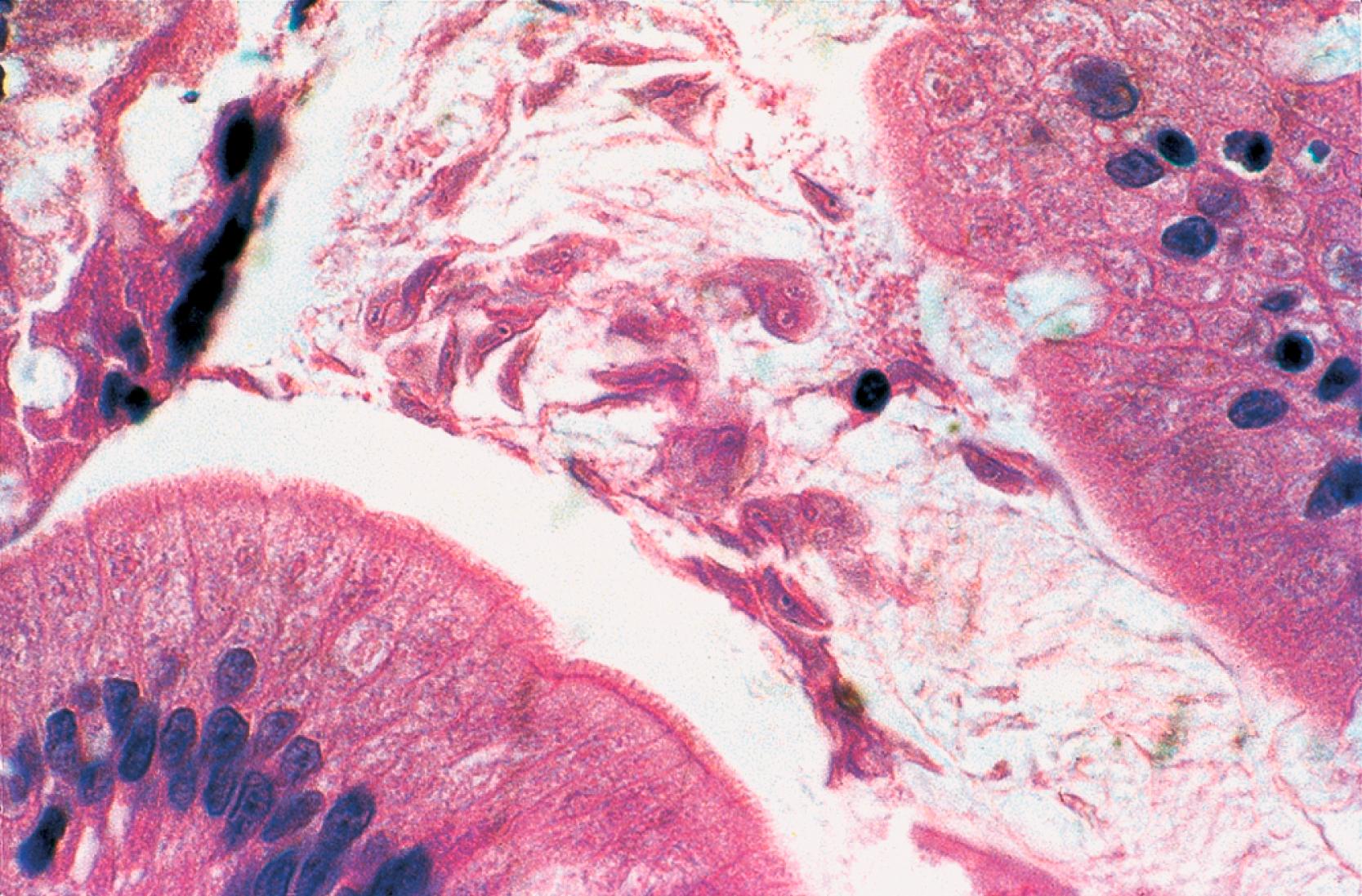
Other GI infections are less common in CVID. Cryptosporidiosis is occasionally found. The prevalence of common bacterial intestinal infections (e.g., Salmonella, Campylobacter ) does not appear to be increased. Although prolonged antibiotic use is common in these patients, an increase in pseudomembranous colitis has not been reported. On occasion, viral and fungal organisms infect the GI tract in CVID patients, but such infections are less common in CVID than in acquired immunodeficiency syndrome (AIDS). CMV infection involving the esophagus, stomach, jejunum, and ileocecal area and resulting in multiple ulcers and obstructing strictures has been reported in a patient with CVID.
In the stomach, a nonspecific increase in lamina propria lymphocytes is seen in some patients with CVID ( Fig. 5.3A ); increased apoptosis of gastric epithelial cells is present in some cases , (see Fig. 5.3B ). In a study of gastric biopsies from 34 patients with CVID and dyspepsia, 41% of patients were infected with Helicobacter pylori . All H. pylori –positive patients and 20% of H. pylori –negative patients had chronic gastritis, and 50% of those infected with H. pylori had multifocal atrophic gastritis. In this study, 10% of H. pylori –negative patients had multifocal atrophic gastritis. Atrophic gastritis resembling autoimmune atrophic gastritis on clinical and morphological grounds (see Fig. 5.3C ) and resulting in pernicious anemia may occur in the absence of demonstrable anti–parietal cell antibodies in these patents. Atrophic gastritis may develop at a very young age in patients with CVID, and it has been reported in a 6-year-old patient who developed multifocal gastric adenocarcinoma at 11 years of age.
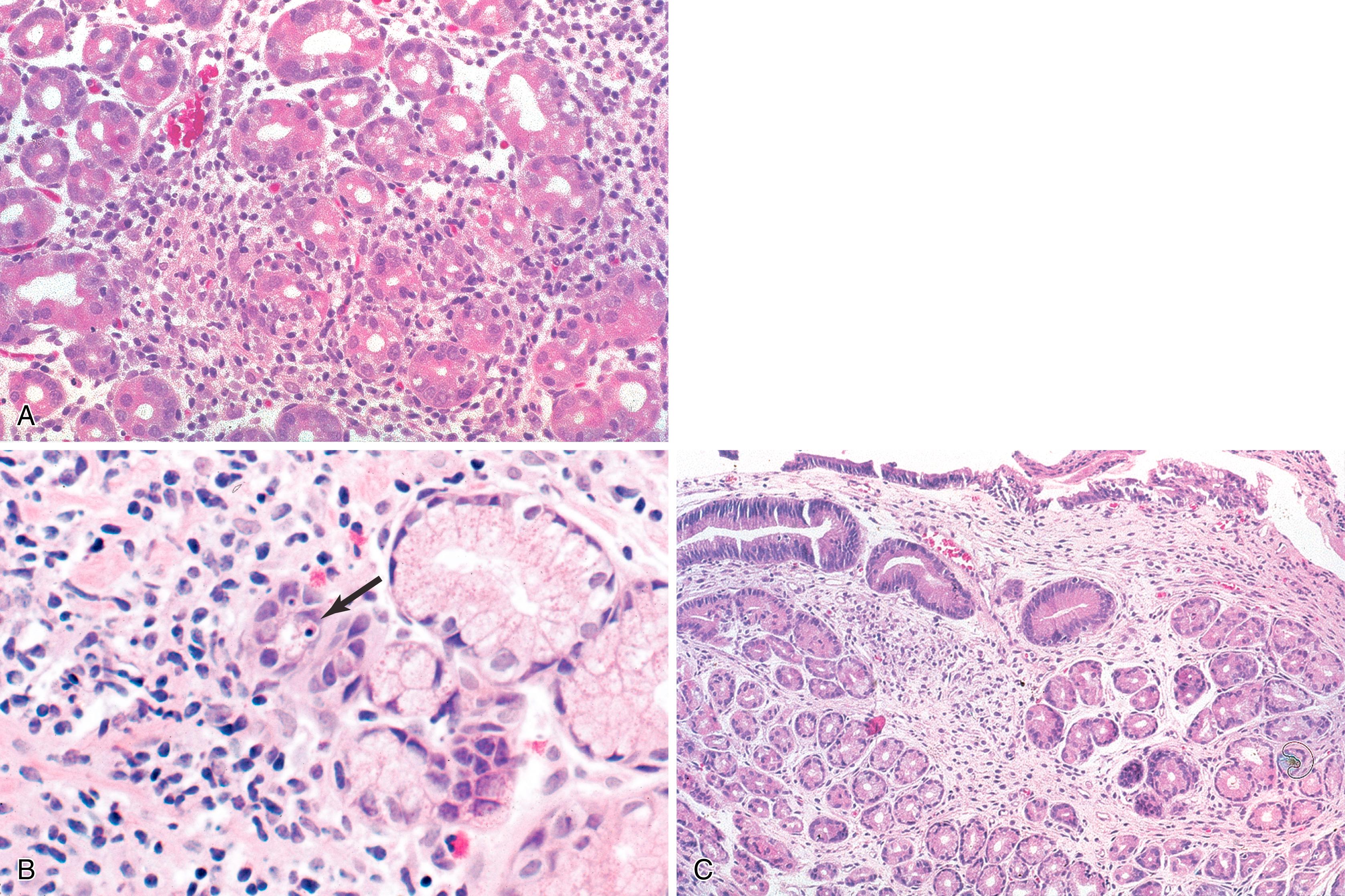
Adults with CVID are also at increased risk for gastric adenocarcinoma. It has been estimated that patients with CVID have a 47-fold increase in gastric carcinoma compared with the general population of Great Britain, and gastric carcinoma ultimately develops in 5% to 10% of CVID patients, usually many years after the onset of hypogammaglobulinemia. However, recent data demonstrate a significantly reduced risk of gastric cancer in these patients, likely resulting from the eradication of H. pylori infection by antibiotics. Atrophic gastritis and intestinal metaplasia in the gastric body are thought to be the main risk factors for gastric cancer in CVID patients. CVID-associated gastric cancers are usually moderately to poorly differentiated intestinal-type adenocarcinomas with prominent intratumoral lymphocytes.
In the small bowel, a spruelike lesion with villous blunting occurs in some patients with CVID and is associated with severe malabsorption, often requiring parenteral nutrition. Villous atrophy associated with CVID generally lacks the degree of crypt hyperplasia seen in celiac disease ( Fig. 5.4A ), but may be indistinguishable on biopsy. In general, the lamina propria inflammatory infiltrate is not as prominent as in celiac disease, and enterocyte maturation is normal, with preservation of the brush border. Most CVID patients with this small bowel lesion do not respond to a gluten-free diet, although an elemental diet may be beneficial, and most respond to corticosteroids, at least initially. Plasma cells are absent or are found only in very small numbers in the lamina propria. Surface intraepithelial lymphocytes are often markedly increased (see Fig. 5.4B ), even in the absence of villous atrophy. In some cases, an increase in apoptotic bodies is found in crypt epithelial cells (see Fig. 5.4C ). Clinical autoimmune enteritis with loss of goblet cells has also been reported.
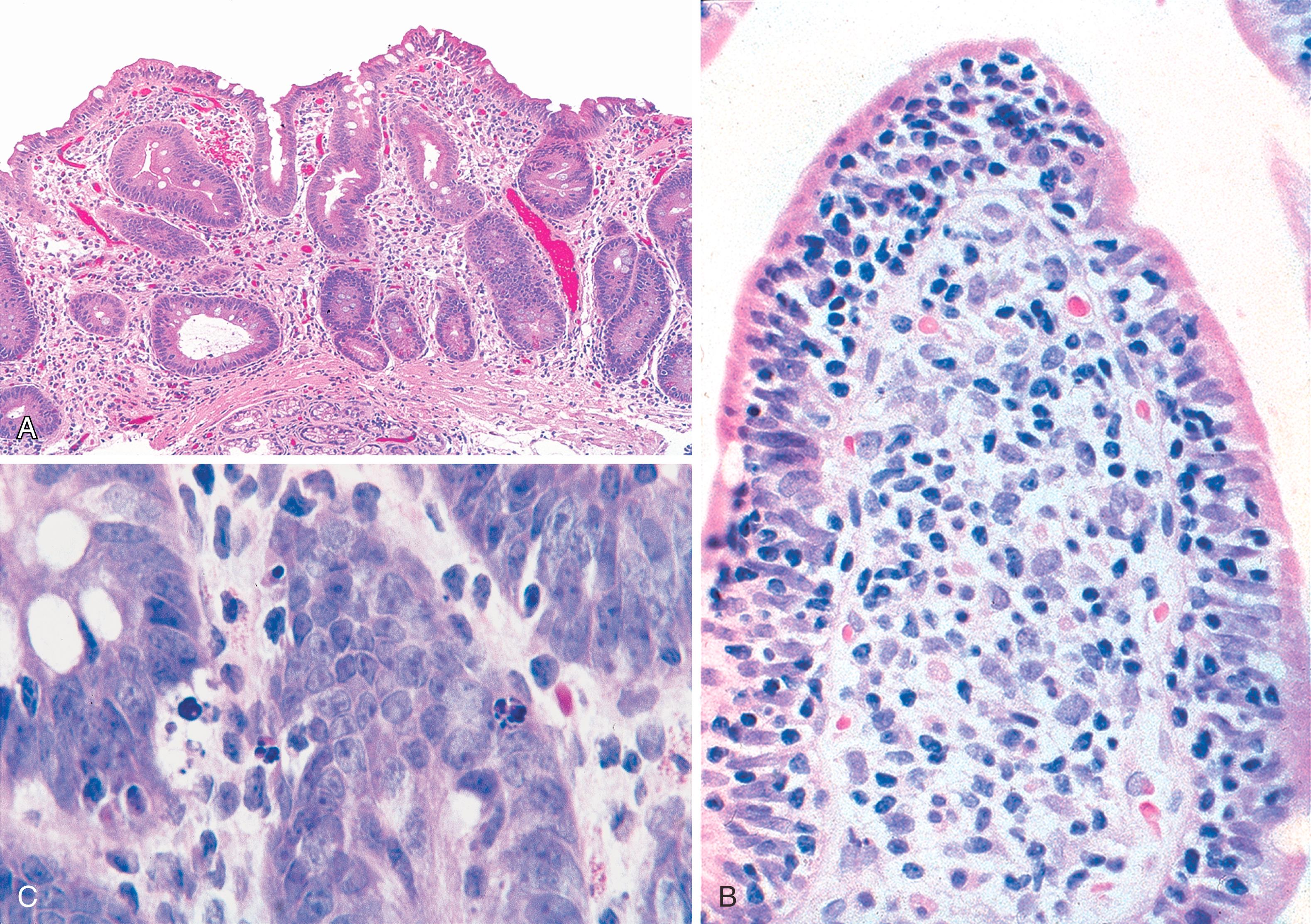
Granulomatous enteropathy has also been reported in patients with CVID and may be associated with protracted diarrhea unresponsive to antibiotic therapy. Poorly formed nonnecrotizing granulomas are found in the lamina propria in multiple sites in the GI tract, including the stomach, small intestine, and colon , ; the diarrhea usually resolves with intravenous immunoglobulin therapy.
NLH in the GI tract is characterized by multiple discrete hyperplastic lymphoid nodules in the lamina propria and submucosa of the small intestine ( Fig. 5.5 ), large intestine, or both, and is probably a result of chronic antigenic stimulation. The germinal centers of the follicles are composed of proliferating B cells with scattered tingible body macrophages; the mantle zones contain mature and immature B cells, and the extramantle zones contain a mixture of cell types including B cells, T cells, and macrophages. NLH is found in as many as 60% of patients with CVID but may be seen in the setting of giardiasis without antibody deficiency. In contrast with NLH in CVID patients, plasma cells are present in the extramantle zones in nonimmunodeficient patients. NLH is not considered a malignant disorder. However, malignant lymphomas of the GI tract in patients with immunodeficiencies often arise in a background of NLH, and clonal immunoglobulin gene rearrangement has been demonstrated in NLH in the GI tract of a child with CVID. Consistent with these observations, the most common malignancy in CVID is NHL, which affects approximately 8% of patients ; these lymphomas often originate in extranodal sites, with small bowel the most common GI site. Most of these lymphomas are of B-cell origin; they include diffuse large B-cell lymphoma (DLBCL) and follicular lymphoma.
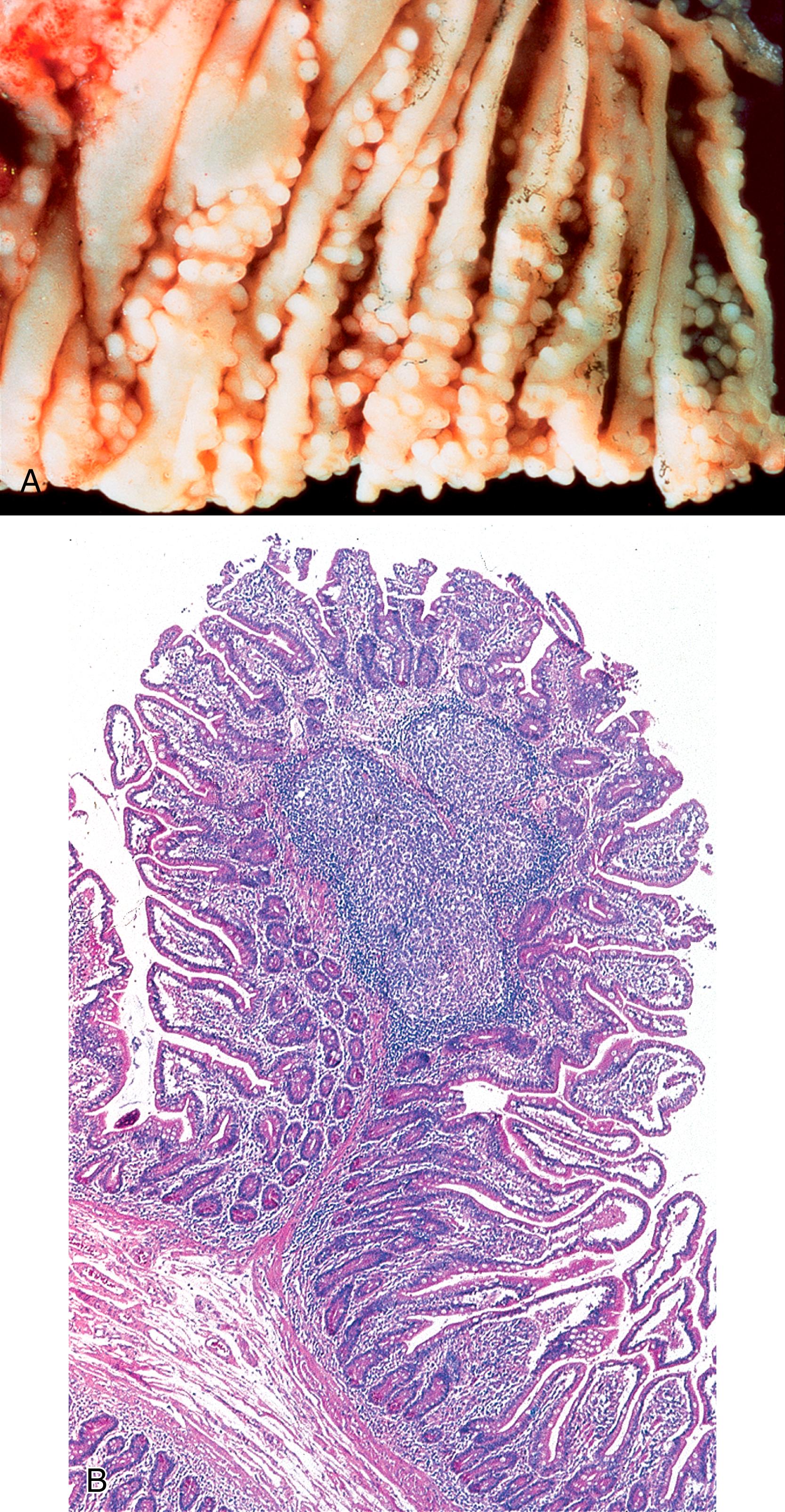
Chronic inflammatory processes involving small or large bowel that are clinically similar to IBD develop in some patients with CVID. In some patients, the small bowel is the primary site of involvement and the lesions resemble Crohn’s disease, with transmural inflammation and small bowel obstruction. Granulomas usually are not present in these Crohn’s disease–like disorders.
The colitis occurring in CVID is variable in morphology. In some patients, the inflammatory process is limited to the colon and clinically mimics ulcerative colitis. Mucosal architectural distortion with crypt destruction is present, although crypt distortion is less pronounced than in most cases of ulcerative colitis, with less crypt branching ( Fig. 5.6A ). Neutrophils are present in the lamina propria and crypt epithelium (see Fig. 5.6B ). In contrast with ulcerative colitis, plasma cells are not present in the lamina propria in CVID-associated colitis, and an increase in CD8+ T cells (compared with normal controls and those with IBD) has been reported in the colons of CVID patients. In some cases, the crypt destruction and mucosal distortion is accompanied by increased apoptosis, and the histology is similar to that of colonic graft-versus-host disease (GVHD). , Milder cases of colitis in CVID may resemble lymphocytic colitis, characterized by increased intraepithelial lymphocytes and minimal mucosal distortion, and an atypical form of collagenous colitis with pseudomembranes has been reported in one patient. The etiology and pathogenesis of colitis in these patients remain largely unknown. The association of chronic GI inflammatory disorders and autoimmune disorders in these patients and the resemblance of the lesions to other disorders of immune dysregulation imply that the colitis of CVID may be autoimmune in origin.

Adenocarcinoma of the colon is reported in young patients with CVID. Small cell neuroendocrine carcinoma of the cecum was reported in a 16-year-old boy, who died of liver metastases 5 months after diagnosis. In another case, 9 adenocarcinomas and 20 adenomas were present synchronously in the colon of a 22-year-old man with CVID.
Become a Clinical Tree membership for Full access and enjoy Unlimited articles
If you are a member. Log in here